Rainbow Rice Sensory Play
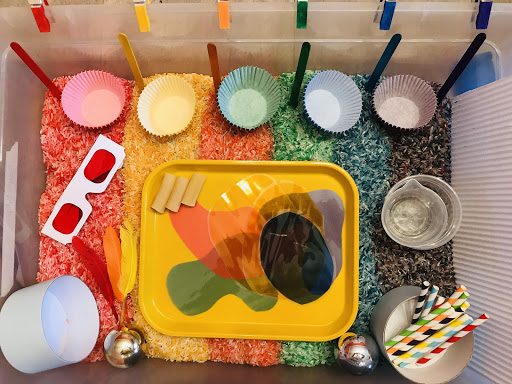
Mini Art Lessons offer open-ended opportunities for caregivers of young children (under age 8) to explore art concepts playfully and intentionally.
Prep Time: 10 minutes
Best for Ages 2–6 (With adult supervision, this activity can be adapted for babies and toddlers)
Adult Supervision Encouraged/Required
Explore color through your senses! Sensory bins are wonderfully versatile for different ages. Only a small amount of set-up is required for prolonged play. Many children will return to the bin time and time again, making this high-quality activity a practical choice for busy caregivers!
TELL ME MORE
What is sensory play?
Young children learn through their senses. Sensory play is play that engages the senses of touch, sight, sound, and sometimes even smell and taste. This sensory play activity is structured to give kids a hands-on exploration of color.
What might kids learn? The Rainbow Rice Sensory Play activity helps children:
- Develop fine motor skills through the repetitive motions of scooping, pouring, and grasping objects during play.
- Explore the properties of different materials (such as color, shape, size, texture, and sound).
- Sort and compare different materials by color, texture, size, and other features.
- Use problem solving to make creations that combine different parts and functions.
GET STARTED
Talk with your child. Do you have a favorite color?
What is your favorite color? Why do you like it? Make a list of all the items that are your favorite color. For example, a list for green might include grass, trees, avocados, broccoli, and frogs.
Artists often add colors to their works. Some artists even focus mostly on color in their creations!
Take a look at these artworks. What do you notice about the colors? Which one do you like best?
TRY IT
Sensory bins are wonderfully versatile. Here are our best tips for setting up a rainbow rice sensory bin, starting with color, but also incorporating many senses for an immersive learning and play experience!
Choose your colors! What colors do you want to create with? The whole rainbow or a select few favorites? Stock your studio with rainbow rice. Try our easy and fun-to-make recipe!
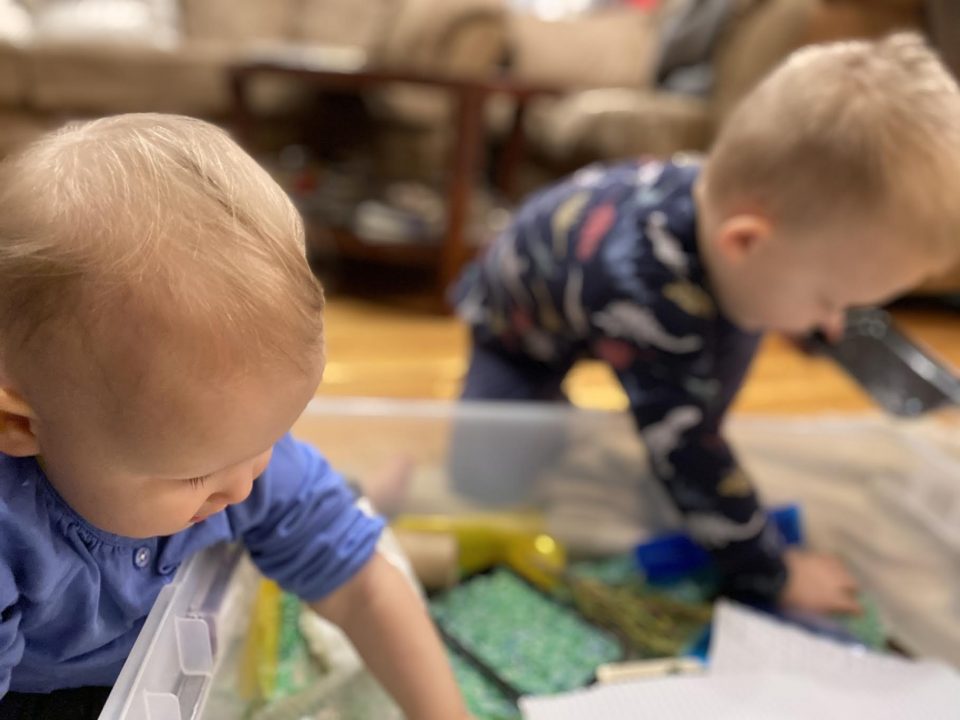
Consider the group size.
Choose a container size to meet the needs of your playmates. A single child will need only a small bin or container, such as a shoebox. A sibling group or peer group will need a larger bin, like an under-bed storage bin. Sensory play can encourage siblings or classmates to practice sharing, taking turns, and parallel play. But you’ll want to keep the experience positive by ensuring that each child has enough space to play comfortably!
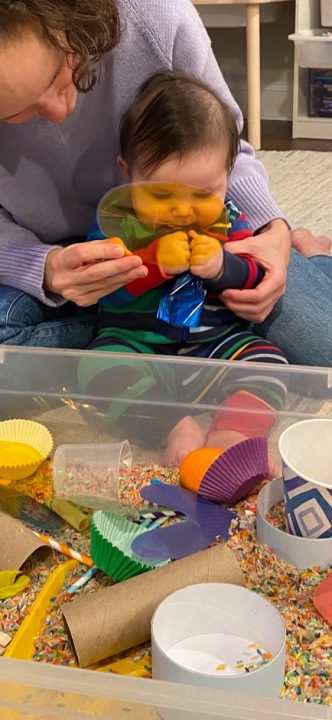
Consider the children’s ages.
Babies will love high-contrast objects, translucent materials that allow for variations of peek-a-boo (see our friend in the photo hiding behind the yellow circle?), and shiny objects that make reflections. They also love sounds. Consider including paper or cellophane to crinkle, or simply scoop and pour rice to let them watch and listen. An adult should always monitor and narrate a baby’s experience.
Toddlers are highly curious and will love opportunities to explore cause and effect. Scooping rice from one container to another or stacking cups or other nesting items together will have endless appeal.
Children ages 3–6 are exercising their imaginations and love creating and acting out stories. Incorporate mini figurines or small toys to encourage dramatic play. Children of this age also need lots of opportunities to practice fine motor skills, which make cups and small utensils for scooping, pouring, and measuring ideal materials.
Consider the child’s interests. Is the child learning colors? Are they a nature fanatic? Interested in sorting and stacking items? Incorporating children’s current interests will encourage prolonged play.

Gather your materials. Exercise caution with children under 3 to avoid choking hazards. Use the toilet paper tube test: if an object fits inside the tube, it’s a hazard. If an object is too big to go inside the tube, it’s safe. We also recommend close supervision of play for children 3 and under.
You’ll need:
- A large sheet or towel to place under the bin (this will help contain spills)
- A bin with sides 6–12 inches tall (taller sides help keep the materials inside)
- Rainbow rice in your favorite colors
- Cups and containers for scooping and pouring (old yogurt containers, cardboard tubes, measuring cups, funnels)
- An assortment of other materials with different properties, such as hollow (straws, cardboard tubes), flexible (pipe cleaners), shiny, or sturdy (cardboard pieces)
- Optional: Translucent colored materials such as cellophane, vellum, or magnetic tiles (these are great for reinforcing color mixing)
- Optional: Materials to encourage imaginative play, such as minifigures, small animal figurines, or small construction vehicles
Assemble!
We designed two different inspiration bins. Each features a large container, rice, and a variety of containers for scooping and pouring. But each addresses different interests and presents different possibilities for exploration and problem solving.
One offers rainbow-colored rice and corresponding materials, perfect for encouraging color sorting.

The other offers only three colors: blue, yellow, and green, alongside items found in nature, such as seed pods and pine branches, a mixture of tools for scooping and pouring, and a magnifying glass.
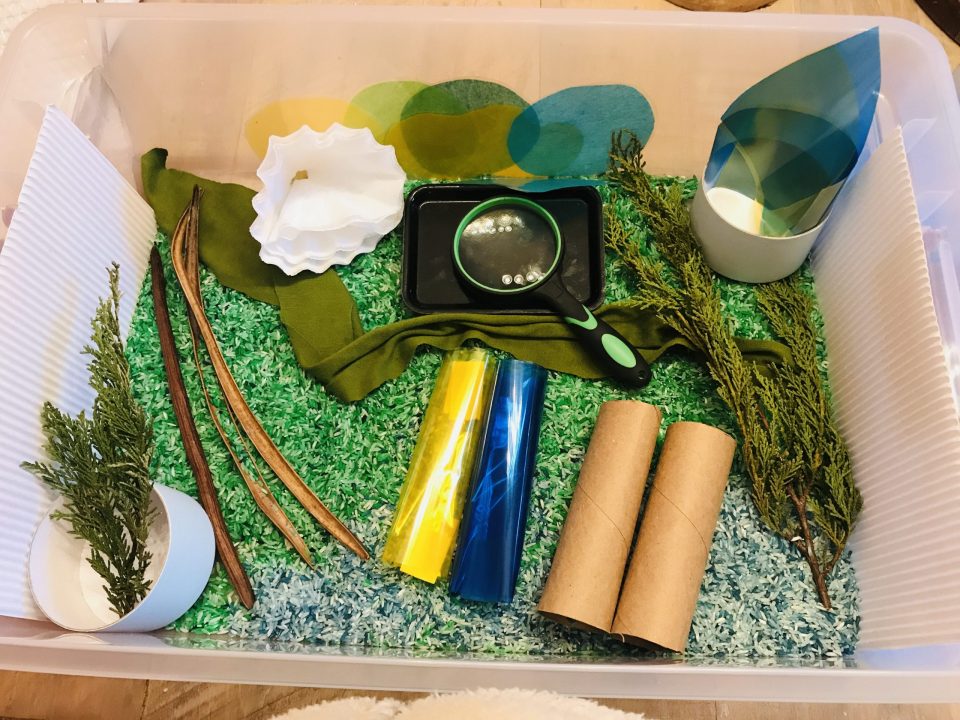
Introduce the sensory bin.
Introduce the bin by first showing the outside of the container. Demonstrate how the tall sides help keep the materials inside (remember: a large sheet placed underneath will catch any spilled materials and make clean-up easier).
Invite your child to play. Use these tips to guide the experience.
- Hold back. Set only a few materials inside at first, then introduce new materials with time. This will help extend play and make the activity last longer.
- Watch your child for a few minutes without talking. Observe closely. What activities and materials interest your child most?
- Play alongside your child, without instructing. Mimic your child’s play while also introducing new actions with the materials. Your child may or may not get interested in what you’re doing. If not, let them continue with their own play.
Help encourage and support the child’s natural interests.
Many children will be interested in scooping, pouring, and making “mountains” of rice. Adults might suggest other containers or materials to try for this activity to level up the play.
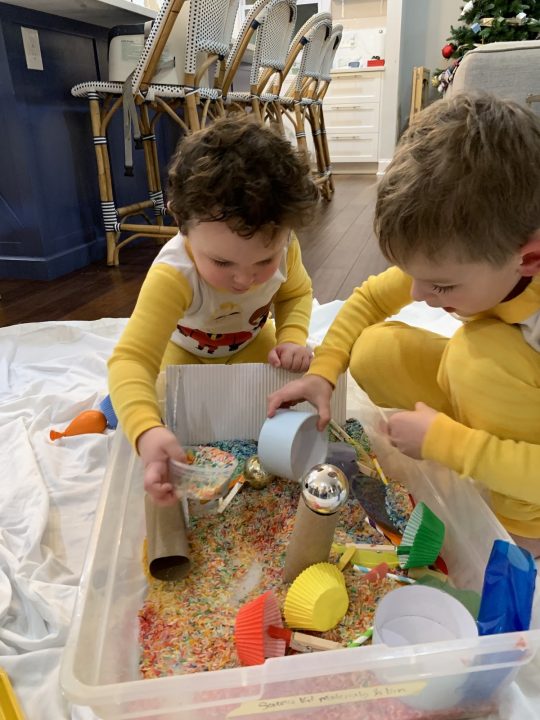
Sorting is a favorite activity for many young children. Here, a five-year-old looks for objects to sort by color. Notice his toddler sibling dancing nearby, feeling the joy in his own separate activity!
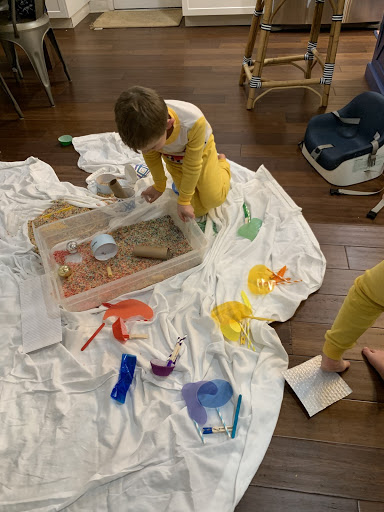
Many children will experiment with combining or using the materials in unusual ways. Here, a three-year-old has set up a structure that props up an elongated seed pod to act like a slide. The rice is poured down the slide.



